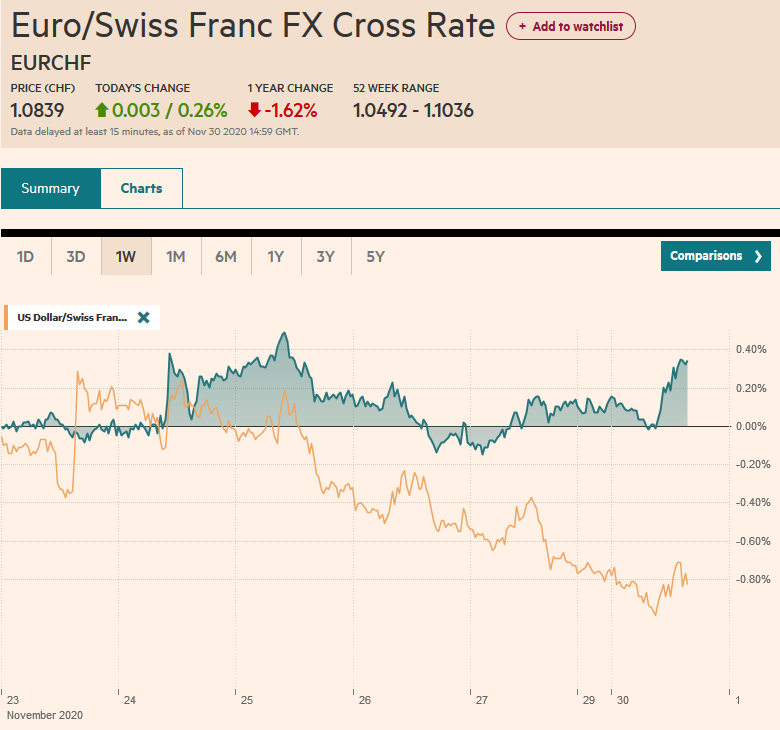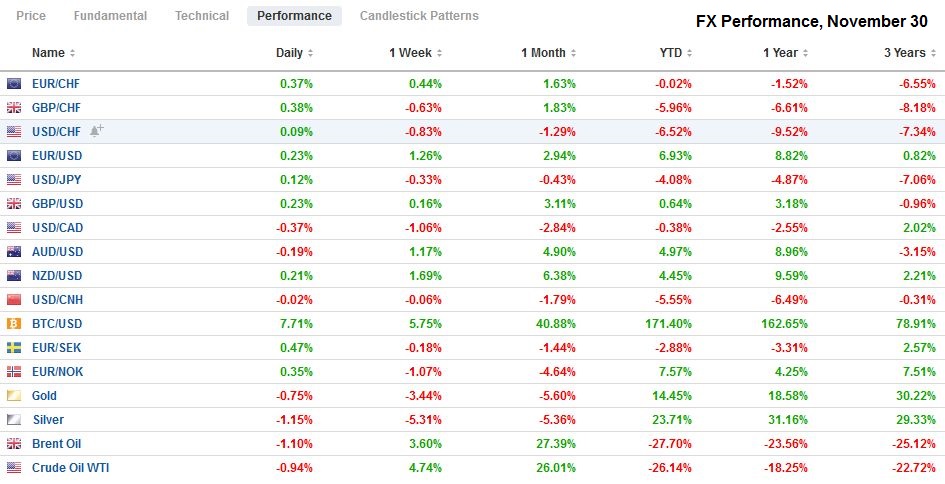Swiss FrancThe Euro has risen by 0.26% to 1.0839 |
EUR/CHF and USD/CHF, November 30 |
FX RatesOverview: Month-end profit-taking saw Asia Pacific shares tumble earlier today. Most markets are off 1-2.5% today after the MSCI Asia Pacific Index rose 2.25% last week. European shares are mixed, but little changed. US shares are also trading lower. The energy sector is being dragged lower by the failure of OPEC+ to signal an agreement to extend cuts, but the formal meeting continues into tomorrow as well. After testing $46.25 last week, WTI for January delivery is Benchmark yields are slightly firmer, leaving the US 10-year near 0.84%, and the peripheral European yields hovering above record lows. The dollar is mostly softer against the majors, led by the Scandis. The euro extended last week’s gains and edges closer to the $1.20 level. Ahead of the RBA meeting, the Australian dollar struggles near $0.7400. Among the emerging market currencies, the ones from the Asia Pacific regions are lower, and the pullback in oil prices has the Russian ruble and Mexican peso joining them. Central and Eastern European currencies are doing better. Meanwhile, gold’s slide was extended to nearly $1764, which is roughly the halfway mark of this year’s range. |
FX Performance, November 30 |
Asia PacificChina’s November PMI was stronger than expected. The manufacturing component rose to 52.1 from 51.4. The non-manufacturing component edged up to 56.4 from 56.2. An extra working day and a rush to complete projects ahead of year-end, which some cite in explanation for the overshoot, were “known unknowns.” The Caixin version, which covers smaller companies, will be reported first thing tomorrow. |
China Manufacturing Purchasing Managers Index (PMI) November 2020(see more posts on China Manufacturing PMI, )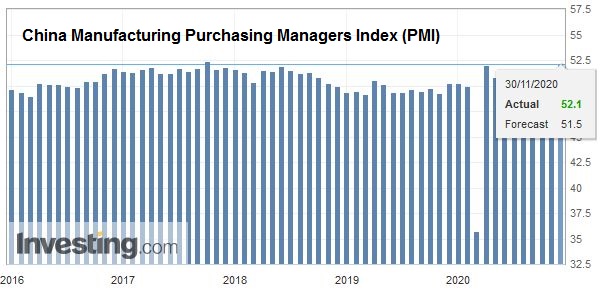 Source: investing.com - Click to enlarge |
| For the record, the composite is at 55.7, the fourth consecutive increase. A year ago, it was at 53.7. |
China Composite Purchasing Managers' Index (PMI) November 2020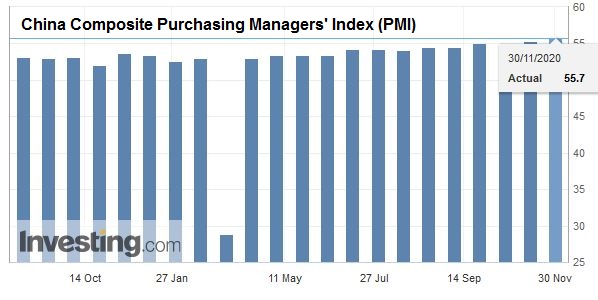 Source: investing.com - Click to enlarge |
| Japan’s manufacturing sector continues to rebound as well. Industrial production rose 3.8% in October, well above the Bloomberg survey’s median forecast for a 2.4% gain. Output rose 3.9% in September. Japanese shoppers also returned in October. Retail sales rose by 0.4%, a little less than expected, but better than September’s 0.1% decline. |
Japan Retail Sales YoY October 2020(see more posts on Japan Retail Sales, )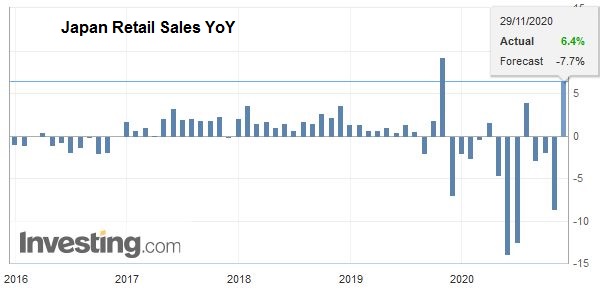 Source: investing.com - Click to enlarge |
The Reserve Bank of Australia meets tomorrow. No one expects it to change policy after last month’s decision to cut rates and buy longer-term bonds. Instead, the focus is on Governor Lowe’s comments on Wednesday and the first estimate for Q3 GDP (Bloomberg survey median forecast is for a 2.4% quarter-over-quarter expansion after a 7% contraction in Q2). Separately, Australia-China trade tensions remain elevated, and wine became the last front.
The largest economies in the region, including China, Japan, India, and South Korea, have a strong oil demand. OPEC+ meets today and tomorrow. The issue is whether it will postpone the increase in quotas that had previously been agreed upon for January. A pre-meeting agreement was not struck over the weekend. With the return of more than a million barrels a day of Libyan output, there may be an abundance of light sweet crude, but the supply of heavy sour appears tighter. Prices appeared to have risen in anticipation that the production restraint would be extended.
The dollar traded on both sides of its pre-weekend range against the yen (~JPY103.90-JPY104.30). A close below the low would be a bearish development, but a shelf had been carved closer to JPY103.65, which should offer support. The Australian dollar extended last week’s gains and briefly traded above $0.7400 today for the first time since September 1 (when the high for the year was set near $0.7415). The defense of an expiring option for A$777 mln at $0.7400 may have helped cap it. A break of the $0.7350 area now would begin forging a top. The PBOC set the dollar’s reference rate at CNY6.5782, in line with the models, as has been the case since the counter-cyclical component was dropped and the fixing became more transparent. The yuan rose about 1.7% in November, the sixth consecutive monthly gain, which is the longest advance in six years. The PBOC unexpectedly injected CNY200 bln (~$30 bln)into the banking system via the medium-term lending facility (at 2.95%). It also added CNY150 bln through seven-day repos. The PBOC has been generous in its additions in the last couple of weeks. The provision of liquidity took the pressure off the money market and bond rates. The nearly four basis point decline in the 10-year yield offsets last week’s gain in full.
Europe
Tomorrow the euro area will report the preliminary November CPI figures. The weakness in price pressures is a critical concern of the ECB, which meets next week. The readings from German states, Italy, and Spain today suggests that there may be a little deterioration. Recall that in October, prices rose 0.2% on the month but were off 0.3% year-over-year, and the core rate was at 0.2%. Those figures alone may have prompted action by the ECB. In addition, the preliminary PMI readings show the social restrictions are impacted the real economy, especially the service sector, as one would expect. New staff forecasts will be unveiled. The ECB is widely expected to expand and extend its emergency bond-buying operations and provide a new long-term lending operation at a rate well below the minus 50 bp deposit rate.
Ideas that the EU’s offer to accept a 15-18% cut in its share of the fishing catch in UK waters made at the end of last week encouraged ideas that a breakthrough was at hand. However, the offer apparently was made more than a month ago and was rejected by the UK then and again yesterday. The UK also wants to renegotiate access to UK waters on an annual basis, while the EU wants a long-term agreement.
More orthodox monetary policy is helping the Turkish lira stabilize. While the international investment community may be less negative, rarely has Turkey been as isolated as it is now. The EU will meet in the middle of next month and consider new sanctions on Turkey for its illegal activity in the eastern Mediterranean. The US will likely sanction Turkey for testing the Russian-made anti-aircraft missile system. Turkey found itself on the opposing side of Russia in the recent Armenia-Azerbaijan war. Riyadh appears to be fostering an unofficial boycott of Turkish goods (meat, eggs, water, milk, and honey). Turkish exports to Saudi Arabia are off 16% in the year through October. Overall the October trade deficit was smaller than expected. Turkey reported Q3 GDP rose 15.6% quarter-over-quarter, which was a bit better than economists expected. Year-over-year, the economy expanded by 6.7% after a 9.9% decline in Q2. Support for the dollar is seen near TRY7.72 and then last week’s low near TRY7.65.
The euro remains firm and has edged closer to the $1.20 level. It is the second consecutive session that the single currency has held above $1.19. Initial support is now seen in the $1.1955-$1.1960 area. We are reluctant to chase it higher amid stretched technical indicators and data showing divergence favoring the US, and ahead of the ECB meeting that is likely to be dovish. Sterling slipped ahead of the weekend after being stymied by offers near $1.3400. It is trading with the previous range and has held above $1.33 (the pre-weekend low was near $1.3290). Meanwhile, sterling is trading near two-week lows against the euro. It is falling for the fourth consecutive session. The euro is knocking on GBP0.9000 after testing GBP0.8865 a week ago.
America
The week sees US auto sales, the Fed’s Beige Book, ISM, the November employment report, and congressional testimony from both Powell and Mnuchin, but begins quietly with the Chicago PMI, Dallas Fed manufacturing survey, and pending home sales. Richmond Fed’s Barkin speaks today. The employment data is the most important, and the pace of improvement is slowing. However, the early call is for the private sector to have added a little more than 600k jobs, which by nearly all reckoning would still be a solid gain. Canada also reports November jobs data at the end of the week, and jobs growth is also moderating. After an 83.6k increase in October (of which 69.1k were full-time postings), Canadian employment is expected to rise by 20k in November. However, tomorrow Canada reports Q3 GDP. The output is expected to have surged by almost 48% at an annualized rate after a 38.7% contraction in Q2. The highlights for Mexico include remittances, which have been strong, PMI, and vehicle production, sales, and exports. Elsewhere, weekend elections give the control of the moderate of Brazil’s two largest cities. This week’s data highlights include November trade and PMI figures, October industrial production, and Q3 GDP (around 9% quarter-over-quarter after a 9.7% contraction in Q2).
It is not immediately clear who was responsible for the assassination of the man credited with being the architect and energy behind Iran’s nuclear effort. Earlier this year, a US drone strike targeted and killed in Baghdad, Major General Qasem Soleimani, was regarded as one of Iran’s most powerful men. In the 2010-2012 period, four leading civilian scientists were assassinated. Last week’s operation reportedly was very sophisticated, involving a robotic rifle from a pick-up truck that quickly exploded after the hit. It puts Iran in a difficult. If it responds, even as ineffectively as it did earlier this year, it makes providing Trump with the ostensible cover he may be looking for to strike Iran. Perhaps more importantly, it would be more difficult for President-elect Biden to reenter the Iran nuclear pact, from which Trump had withdrawn. If Iran does not strike back, it looks weak domestically and undermines deterrence, keeping its adversaries at bay, knowing Tehran has the ability and will to retaliate.
The US dollar is being sold through the pre-weekend low (~CAD1.2970) and is nearing the spike low of CAD1.2930, which is also the year’s low. Resistance is seen in the CAD1.3030 area. The greenback’s downward momentum against the Mexican peso faded in the second half of last week as bids emerged in the MXN19.94-MXN19.95 area. It tested initial resistance in the MXN20.10 area in late Asian turnover, a four-day high. Above there, last week’s high comes into view (MXN20.16-MXN20.18). Against the Brazilian real, the dollar has found support this month near the 200-day moving average that is found near BRL5.30. Last week’s high was set near BRL5.45 and offers initial resistance.
Graphs and additional information on Swiss Franc by the snbchf team.
Full story here Are you the author? Previous post See more for Next postTags: #USD,$CNY,Brazil,Brexit,Currency Movement,ECB,Featured,newsletter,OPEC,RBA,Turkey









